Food to Help Focus: Unlock the Power of These Brain-Boosting Foods
The ability to focus plays a crucial role in our lives, both day-to-day and long-term. It is critical for taking in new information, learning new things, executing daily tasks and achieving goals. How well we can concentrate can influence our levels of success, and focus levels can, unfortunately, dwindle as we get older.
Several factors can affect concentration, such as brain training, stress management, environmental elements and sleep. What we put on our fork can also have a significant influence on our ability to focus.
If you want to explore different types of food to help focus, here are many nutritional strategies and specific foods that improve memory and concentration.
Nutrition Strategies

Follow a Balanced Diet
Food is fuel for the brain and body, and a diet lacking essential vitamins, minerals, macros and nutrients can hinder your ability to focus. Following a general healthy nutritional plan improves all cognitive processes in the body, including concentration.
When seeking out food to help focus better, try to take in a balance of complex carbohydrates such as brown rice or sweet potatoes, protein sources such as lean, unprocessed meats, eggs or soya, and healthy fats such as avocadoes, nuts and seeds. Aim for an abundance of fruits and vegetables, including a rainbow of different colored ingredients as well as a wealth of leafy greens such as kale and spinach.
It is not only different foods that improve memory and concentration, but water as well; it is crucial to drink plenty of water throughout the day. You can also reduce certain types of food to help focus. Limit your intake of processed foods, refined sugar, empty calories (foods with low nutritional value) and trans fats.
Don’t Skip Breakfast
Studies have found that eating breakfast may help improve attention and short-term memory, with those skipping breakfast not performing as well on academic tests as those who didn’t. In particular, high-fiber whole grains, dairy and fruits tend to garner more positive results as types of food help focus, while high-calorie meals appear to hinder concentration.
Try Smaller Meals More Often
Blood sugar plays an important role in the body as a whole, specifically in concentration. When blood sugar levels are too low, there isn’t adequate energy for brain function, often resulting in poor attention and cognitive function.
Eating smaller meals more frequently helps maintain balanced blood sugar levels that don’t spike or drop too often. Lower GI foods (those that have little effect on the body’s blood sugar, such as leafy greens, high fiber foods and healthy proteins) also help to stabilize blood sugar between meals and avoid sugar crashes.
Specialty Foods

Caffeine
Well-touted for its abilities to provide a mental boost, caffeine is one of the most frequently utilized tools when seeking out food to help focus. It is found in coffee, energy drinks, certain teas, chocolate and some medication, and has been shown to increase alertness, elevate mood and sharpen concentration.
Fatty Fish
Many sources of fish are high in omega-3 fatty acids – key nutrients and major building blocks for the brain. Diets inclusive of fish such as salmon, trout, sardines and low-mercury tuna are linked to improved memory, cognitive function and learning ability, particularly as we age, making them an ideal source of food to help focus.
Blueberries
Blueberries and other deeply colored berries contain plant compounds that offer anti-inflammatory and antioxidant effects. These nutrients serve as helpful food to help focus by protecting the brain against ageing and neurodegenerative diseases. Some of the antioxidants in blueberries specifically have been found to accumulate in the brain, helping to improve the communication between brain cells.
Dark Chocolate
Part of the focusing power behind dark chocolate and cocoa is the caffeine content, boosting their status as foods that improve memory and concentration. But these foods also offer rich supplies of flavonoids and antioxidants. These offer more than the temporary effects of caffeine by enhancing overall health and therefore brain function long-term.
Turmeric
Curcumin is the active ingredient in turmeric. It has been shown to directly enter the brain (skipping the bloodstream) and potentially help new brain cells grow, boost memory and delay age-related mental decline that affects concentration.
Broccoli
This powerhouse food to help focus contains a variety of compounds with powerful anti-inflammatory and antioxidant effects. One of these is vitamin K, which has been linked with better cognitive performance and improved memory.
Walnuts
Coincidentally resembling a brain shape, walnuts are most well-known for their brain-boosting benefits. In addition to the antioxidants, healthy fat, fiber, protein and vitamin E that many nuts contain, walnuts also supply omega-3 fatty acids, recognized for their ability to support the brain’s function, including concentration.
Green Tea
Green tea is another healthy source of caffeine, although it has other beneficial ingredients that make it an ideal food to help focus. L-theanine in particular helps mitigate the anxiety-inducing effects of caffeine, supporting a mind state that is both attentive and relaxed – ideal for concentration. Studies conclude that green tea may improve alertness, memory, performance and focus.
Pumpkin Seeds
Pumpkin seeds contain many micronutrients that support brain function, including copper, iron, magnesium and higher levels of zinc than most other seeds. Magnesium helps reduce mental stress while zinc is vital for enhancing the memory and thinking skills that help us focus.
A Note on Sugar

While the many health pitfalls of excess sugar are accurately documented, it is worth noting that sugar can be considered a useful food to help focus as it is still the brain’s preferred source of fuel. This source, however, is glucose, not refined sugar. The body processes glucose from the sugars and carbohydrates in the diet, and receives a spike in energy levels that bolsters mental alertness. This temporary boost in focus may prove helpful when limited bursts of concentration are required, but the effects are short-lived, and followed by a drop in sugar levels that can result in tiredness and distractibility.
If you need a quick, short boost in your attention, skip refined sugar and try whole fruits, which include the fiber, vitamins and minerals to make them a more wholesome food to help focus.
While many approaches can help enhance mental performance, you can effectively support your brain health and boost your focus, alertness, memory and mood by adopting certain nutritional strategies. You can also include more of these specific foods that improve memory and concentration in your diet as part of a targeted strategy to increase focus.
How to Deal with Tailbone Pain: Causes and Treatment Strategies
Coccydynia - more commonly known as tailbone pain - is a medical condition that can cause mild discomfort or severe issues.
Tailbone pain can stem from many different sources, including injuries, arthritis, and nerve problems. Understanding the condition and finding the underlying cause is crucial to choosing the right treatment options and alleviating pain.
In this article, we will learn about the characteristics of tailbone pain, possible causes, and available treatment options.
Understanding the tailbone and its function
The tailbone, or coccyx, is a group of three to five vertebrae fused to form a single bone. You can find the coccyx below the sacrum bone, at the bottom of the spine.
It's a common belief that the coccyx serves no purpose in the human body. While it's true that it no longer fulfills its original function, it still provides an attachment point for multiple muscles, tendons, and ligaments in the pelvic area. It also serves as a point of balance when sitting.

Characteristics of tailbone pain
Coccyx pain may vary in severity and the feeling of pain. It might manifest as a dull, stabbing, piercing, or burning sensation.
The pain might worsen when sitting for extended periods, standing up after sitting, and during bowel movements, menstruation, or sex.
In addition to pain, one might experience numbness, tingling, muscle weakness in the legs, or bowel and bladder problems. These symptoms might signal a nerve issue and should always be checked by healthcare professionals.
Some conditions might cause tailbone pain, among other symptoms. Arthritis, sciatica, and spinal stenosis are a few examples.
Causes of tailbone pain
Tailbone pain is a common condition that many adults experience at some point. Women are at a greater risk than men, and obesity is another risk factor for coccydynia. Most of the time, the causes behind coccyx pain are only temporary issues, but in some rare cases, it might result from some chronic condition.
Tailbone injury
A common cause behind tailbone pain is injury. Following a fall or accident, the tailbone might break or fracture.
Doctors will perform X-ray scans to determine the severity of the damage and the course of treatment. If there aren't any fractures or broken bones, a bruised tailbone can heal with rest alone.
Physical stress on the tailbone
Repeated stress to the tailbone may lead to mild or even severe pains. This might result from poor posture, sitting in an uncomfortable position or on a hard surface, added pressure to the bone due to being overweight, or sports like cycling or rowing. Being underweight might also cause issues, as the lack of fat to cushion the tailbones might put more stress on the coccyx when sitting, or the bone might rub against muscles, ligaments, and tendons in the pelvic area.
Pregnancy
Pregnancy is a natural cause of pelvic and tailbone pain. During the later stages, joints loosen in the area, allowing bones to move around and give space, causing muscles and ligaments to stretch, leading to pain. This is a natural process, and the pain usually goes away after pregnancy.
Infections
Viral, bacterial, or fungal infections might affect any area in the body, including the bones and the tissues around them. They might cause inflammation, swelling, and pain. In addition to inflammation and pain, fever is a common symptom in these cases. It's vital to contact your healthcare provider as soon as possible if you suspect an infection.

Tumors and other growths
In rare cases, abscesses, tumors, cysts, or other growths like bone spurs might pressure the tissues or nerves around them. This might lead to pain symptoms. Prostate cancer, chordoma, vertebral tumors, colorectal cancer, and pilonidal cysts might all cause pain in the tailbone.
Diagnosing tailbone pain
When diagnosing coccydynia, doctors will ask about your medical history and recent physical traumas like falls, accidents, or childbirth. They will also check for fractures, bone deformities, infections, and growths.
X-rays, CTs, MRIs, and bone scans can provide a reliable picture of the underlying issues and help doctors determine the appropriate course of treatment.
Treatment options for tailbone pain
A sore tailbone might heal with proper rest and home treatment. In some cases, though, underlying issues have to be addressed.
Correcting outside factors
The cause of tailbone pain is often repeated stress to the area. In these cases, one might need to make some lifestyle adjustments. Correcting a poor posture, spending less time sitting, adjusting your sitting position or surface, and maintaining a healthy weight might all contribute to the healing of tailbone pain and avoiding future issues.
Using an ergonomic chair, avoiding restrictive clothing, and using a donut pillow to sit on might also be good ways to help with recovery. In some cases, gentle stretches and light tailbone pain exercises can also be beneficial. Strengthening the muscles around the pelvic area will help stabilize the joints and provide additional support.
Pain relief for tailbone pain
Since tailbone pain often goes away with rest, treatment might be limited to pain management during the healing process. Especially in the case of long-standing or chronic coccydynia, pain relief is a vital part of treatment.
Physical therapy, stretches, or massage can be an effective method to ease tailbone pain.
Painkillers like paracetamol, NSAIDs, or steroid injections can offer pain relief and treat inflammatory symptoms.
Drug-free pain management options like innovative pain patches, herbal remedies, and thermal therapy might be worth considering if you want to avoid the side effects of traditional drugs.
When it comes to tailbone pain, avoiding further stress and trauma, maintaining a healthy posture, and using ergonomic chairs might be your best long-term pain relief options.
Tailbone surgery
In rare cases, doctors might recommend surgery. Total or partial coccygectomy means removing the entire tailbone or parts of it. Tumors or other growths might also get removed using surgical methods.
Spinal Stenosis: What You Can Do to Prevent and Manage It
Spinal stenosis is a common source of back pain caused by the narrowing of the spinal canal and irritation of the spinal cord. The causes might vary, and depending on where the pain occurs, we can distinguish between different types of spinal stenosis. Understanding the underlying issues, symptoms, and available treatment methods can bring you closer to getting relief for your back pain.
What is spinal stenosis?
The spinal canal is a space that runs through the entire length of our spine, surrounded by vertebrae. Its function is to protect the spinal cord and the spinal nerves.
Spinal stenosis is a medical condition where the space in - or around - the spinal canal narrows, restricting the nerves or the spinal cord, leading to nerve pain and other symptoms.
Types of spinal stenosis
We can distinguish between different types of spinal stenosis depending on which part of the spine (lumbar, thoracic, or cervical) they occur in and if they affect the spinal cord or the nerves branching from it.
Lumbar spinal stenosis
Lumbar stenosis is the most common form of spinal stenosis and affects the lower back (from L1 to L5 vertebrae). Symptoms can be felt throughout the back, the buttocks, or the legs.

Cervical spinal stenosis
Cervical stenosis occurs in the neck area of the spine (from C1 to C7 vertebrae), which might cause tingling, numbness, nerve pain, and muscle weakness in the neck, radiating to the shoulders, arms, and hands. In some cases, cervical stenosis might also cause muscle weakness in the legs and balance problems.
Central canal stenosis
Central canal stenosis happens when the center part of the spine, the spinal canal, narrows, putting pressure on the spinal cord or the cauda equina. It might cause inflammation and weakness in the back and other affected areas.
Foraminal stenosis
Many nerves branch out to the sides of the spinal cord. These are called spinal nerves, and they go through the nerve root canals found on the sides of the spine. When these canals get constricted, it can pressure these nerves, causing foraminal stenosis, also known as lateral stenosis. This might lead to nerve pain, muscle weakness, numbness, and tingling in various areas depending on the affected nerves.
Spinal stenosis symptoms
The symptoms of spinal stenosis can vary depending on whether it affects the spinal cord or the spinal nerves and the area of the spine where the problem occurs.
Some people with spinal stenosis might never have any symptoms, while others might experience a wide range of them. Spinal stenosis might cause the following symptoms:
- Back- or spine pain
- Nerve pain in the limbs, shoulders, buttocks, neck, or the back
- Tingling sensation
- Numbness
- Muscle weakness
- Balance problems
- Difficulty controlling bowel or bladder movements
The symptoms of spinal stenosis often occur slowly at first and worsen gradually over time. Certain positions might alleviate the pressure on the nerves, temporarily making these symptoms less apparent.
Spinal stenosis might lead to other, more specific, medical conditions. We will list some of these below.
Cauda equina syndrome
The cauda equina is a group of nerve roots at the bottom of the spine, in the lumbar and sacral area. These nerves play a vital role in controlling bladder and bowel functions and the movement of the legs. If these nerves get constricted, it might cause problems in these areas, a condition called cauda equina syndrome. If you experience nerve pain and difficulty controlling the functions mentioned above, you should seek medical help immediately.
Sciatica
The sciatic nerve stems from the lower back and runs throughout the buttocks and the legs. Its function is to transfer sensations and control movement. When the sciatic nerve gets irritated or constricted, it might lead to burning or needle-like pains, tingling, and numbness in the affected areas. This condition is called sciatica.
Neurogenic claudication
Neurogenic claudication, also known as pseudo-claudication, is a common symptom of lumbar spinal stenosis. The compression of the spinal nerves causes nerve pain, tingling, numbness, weakness, heaviness, or cramping in one or both legs. A characteristic sign of neurogenic claudication is that it might get better or worse, depending on your posture. You might experience relief when leaning forward or sitting down.
Spinal stenosis causes
Spinal stenosis might occur naturally due to old age, but in most cases, it goes unnoticed without any symptoms. However, some underlying causes might lead to more severe spinal stenosis, where the symptoms are apparent and can have a severe impact on your everyday life.
- Injuries - Accidents, blunt force trauma, sprains, or other issues might damage the bones, muscles, ligaments, or tissues around the spine, leading to spinal stenosis.
- Bone growths - Osteoarthritis, Paget's disease, or other conditions can lead to unnatural bone spurs in the spinal area. These bone growths might constrict the spinal canal or nerve root canals and lead to spinal stenosis.
- Inflammation or infections - Overuse, inflammatory arthritis, autoimmune diseases, or infections might cause inflammation in the surrounding tissues, potentially leading to swollen muscles or thickened ligaments pressing on the spinal cord or the nerves.
- Disk problems - The spinal disks are soft, shock-absorbing cushions in the spine. These disks might get misaligned, herniated, or damaged in other ways, pushing into the spinal canal, causing nerve irritation.
- Tumors or other growths - In rare cases, tumors or other tissue growths might occur near the spine, potentially constricting the available space and leading to nerve problems.
- Poor posture - Severe cases of poor posture or keeping the spine in unnatural positions for long periods of time might also lead to spinal stenosis.
The risk factors for spinal stenosis include old age, repeated stress or injury to the spine area, and poor posture.
Diagnosing spinal stenosis
When diagnosing spinal stenosis, your doctor will perform a physical examination and ask about your symptoms and medical history.
Spinal stenosis is fairly easy to diagnose using X-rays and MRI or CT scans. These imaging tests often reveal the source of the issue, showing herniated disks, bone spurs, tumors, and muscle or ligament damage.
Spinal stenosis treatments
The recommended treatment methods for spinal stenosis largely depend on the underlying issue. Doctors will focus on solving the causes while providing relief for the symptoms.
Physical therapy
Physical therapy can help alleviate spinal stenosis symptoms or even fix the problem entirely. Building muscle strength can help stabilize the spine, gentle stretches can help realign the bones, and massage or other forms of movement might help with swollen muscles.

Certain forms of exercise might improve flexibility and balance as well.
Pain management
Pain management is a vital part of most treatment plans. It can make the healing process more comfortable or provide relief for chronic cases of spinal stenosis.
- Analgesics - These simple painkillers might provide relief for minor pains
- Nonsteroidal anti-inflammatory drugs - NSAIDs can alleviate pains while at the same time reducing inflammation in the body
- Steroid injections - Steroids are potent medicines that can help with inflammation, swollen tissues, and severe pain
- Opioids - Opioids provide very strong pain relief, but because of their addictive nature, they are usually only considered a last resort option
- Alternative pain relief options - Herbal medicines, natural agents, and drug-free pain management options can help relieve pain with minimal side effects or provide a supplementary pain management option alongside traditional methods
Surgery
Doctors might recommend surgery in some cases, which might correct issues like herniated disks or bone deformities. The goal is to expand the available space in the spinal or nerve root canals.
Sciatica Pain Relief – What Are Your Options?
Sciatica is a painful condition that can hinder your movement and everyday life.
Finding the proper treatment methods is essential to relieve sciatic nerve pain and restoring your range of motion and balance.
In this article, you will learn about sciatica treatments, their pros and cons, and home remedies for sciatic pain.
Understanding sciatica pain
Before we get to sciatica treatments, it's crucial to understand the condition itself.
The sciatic nerve stems from the lower back and extends into the legs. Its function is to transfer sensations and regulate muscle movement. When this nerve is irritated or damaged, it might cause sharp or burning pain, numbness, tingling, muscle weakness, or even paralysis in the buttocks, the legs, or the lower back. We call this condition sciatica.
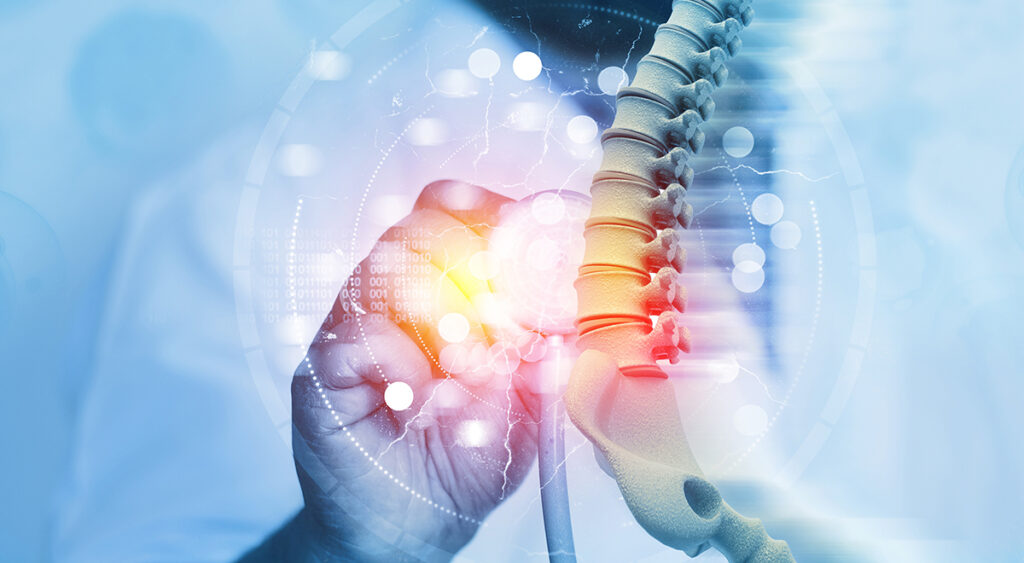
The causes of sciatic nerve pain can vary, ranging from underlying spinal conditions and herniated discs to muscle imbalances and physical trauma. Sciatica often stems from irritation to the sciatic nerve, like swollen muscles or bone spurs rubbing or pushing on the nerve.
Treating sciatica
When it comes to sciatica treatments, diagnosing the source of the issue is vital because treatment methods might vary for each.
When the underlying issues are simple problems like overuse of muscles or a joint sprain, sciatic pain might get better simply with rest. In other severe cases, like bone deformities, herniated discs, or tumors, surgery might be the only viable option.
Treating the underlying causes of sciatica
While finding relief for sciatica symptoms is vital, at the same time, doctors will aim to identify and treat the source of the issue.
Rest
Sciatica might stem from swollen muscles pressing on the nerves, which may occur due to overuse, inflammation, muscle strain, or other milder issues.
If there's no other underlying problem behind the sciatic nerve irritation, resting the muscle or ligament that causes sciatic nerve entrapment might be all that is needed.
Physical therapy for sciatica
Sometimes, sciatica might result from muscular abnormalities, bad posture, or keeping the lower spine in an unnatural position for extended periods.
Physical therapy, like stretches, strengthening exercises, and posture correction, might be enough to cure sciatica by removing the irritation on the sciatic nerve.
Medicine-based approaches
In some cases, the underlying cause behind sciatica might be some inflammatory disease, infection, or other condition that can be treated or cured by taking some drugs. These diseases might lead to swollen muscles, temporarily deformed disks or other factors that cause sciatic nerve irritation.
Doctors might recommend antibiotics, nonsteroidal anti-inflammatory drugs (NSAIDs), steroid injections, or other drugs.
Surgery for sciatica
When other treatment methods fail to bring results, or the source of sciatica requires immediate intervention, doctors might advise surgical approaches. This usually happens if your sciatica gets more severe and you experience symptoms like paralysis, muscle weakness, or difficulty controlling bladder or bowel movements.
Cauda equina syndrome, tumors, herniated disks, or central spinal stenosis are some underlying issues that might require surgical approaches.
Sciatica pain relief
The main symptom of sciatica is nerve pain that might feel like burning or a pins and needles type of sensation. It usually occurs in the lower back, the buttocks, or throughout the legs. Most of the time, sciatica pain is only apparent on one side of the body. In rare cases, it might affect both sides, signaling possible spinal damage that requires immediate attention.
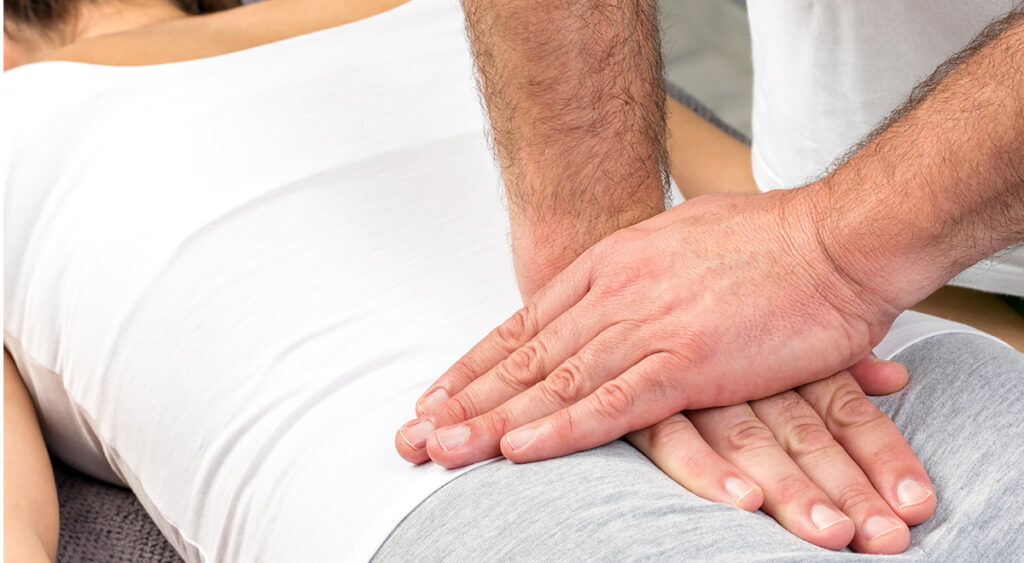
Sciatic nerve pain relief is a vital part of any treatment effort. Let's take a look at available pain management options.
Painkillers for sciatic pain
Traditional painkillers can bring immediate relief for sciatica pain in most cases. They are the most reliable and widely available pain management options. Their downside lies in the possible side effects, especially when taken over long periods.
Depending on the severity of the pain and the underlying causes, doctors might recommend different types of drugs.
- Analgesics - Simple painkillers, like paracetamol, can help relieve minor pains.
- NSAIDs - Nonsteroidal anti-inflammatory drugs reduce pain and inflammation at the same time.
- Steroid injections - Epidural steroid treatments can offer potent pain relief and treat inflammatory diseases when other methods fail to bring results.
- Opioids - Opioids are strong painkillers that can effectively treat even severe pains. However, they are usually recommended only as a last resort because of the risks of addiction.
Alternative remedies for sciatica pain relief
If you want to avoid the side effects of traditional drugs, alternative pain relief techniques might be the right option for you. Some of these methods require professional care, while others are easy ways to start your sciatica pain treatment at home.
- Acupuncture - Acupuncture is a traditional Chinese practice backed by scientific research. It utilizes needles to ease pains and treat various conditions.
- Massage therapy - Professional massage therapists can help ease muscle tension and remedy swollen muscles, which might help relieve sciatica symptoms.
- Thermal therapy - Heat and cold therapy are both effective and science-backed ways of pain management, and they can be easily done at home.
- Herbal remedies - Some herb-based solutions can help ease mild pains. Herbal ingredients, like capsaicin, lavender oil, and Boswellia, are often used in these products.
- Drug-free pain patches - Pain patches utilizing innovative technologies can offer effective and localized pain relief without the side effects of traditional painkillers.
Lifestyle changes and prevention for sciatica
Some minor lifestyle changes can help ease your existing symptoms and decrease your risk of developing sciatica in the future.
- Stay active - Keeping your muscles and joints in good shape is essential. Yoga, swimming, and other low-impact exercises can strengthen your core muscles, improve flexibility and joint health, and promote a healthier lifestyle overall.
- Avoid stressors - If you're at risk of developing sciatica, it's often advised to be mindful of stressors that might cause muscle or joint damage. Avoid overuse, lifting heavy objects, or physical trauma, whenever possible.
- Manage your stress levels - While stress doesn't directly lead to sciatica, it might be a contributing factor, as it increases muscle tension and the risk of certain diseases and conditions. Meditation can be an effective way to reduce both stress levels and pain perception.
Nerve Pain Causes: Exploring the Underlying Conditions
Nerve pain is a specific type of pain in the body that results from damage or irritation of nerves. Symptoms and causes can differ widely.
In this article, we will help you understand nerve pain in general and talk about treatment options and the potential causes of nerve pain.
What is nerve pain?
The nervous system is a complex network that fulfills an essential role, regulating the body and transmitting vital information like sensations, feelings, commands, and other signals. Nerves are cable-like bundles of nerve fibers threading through the entire body, acting as highways for these signals.
Nerve pain is a sensation that occurs when one or more of these nerves suffer from damage, irritation, or other disruptions.
The symptoms of nerve damage can manifest in different ways, depending on the affected nerves and the severity of the underlying issues. Neuropathic pain is usually characteristic enough to distinguish it from other sources of pain. It might feel like a tingling, shooting, stabbing, electric, needle-like, or burning sensation. Numbness is a common symptom as well.
The affected area often gets sensitive to touch. One might also experience loss of balance due to nerve damage.
What causes nerve pain?
The underlying causes behind nerve pain can be diverse. It might stem from numerous neurological disorders, poor blood supply, nerve diseases, nerve damage, or the compression or irritation of the nerves.

Neuralgia
Neuralgia refers to a specific type of intense and sharp nerve pain that occurs along the path of a nerve. The condition usually develops due to nerve damage or irritation. Neuralgia has many different types, depending on the underlying causes and the affected nerves.
Trigeminal neuralgia
Trigeminal neuralgia is a chronic pain disorder that occurs due to irritation or compression of the trigeminal nerve. This nerve is responsible for transmitting sensations in the face. The main symptom is sudden, severe, electric shock-like pains that usually occur only on one side of the face.
Treatment for trigeminal neuralgia involves medications to ease the symptoms and, in some cases, surgical procedures to relieve pressure on the trigeminal nerve.
Occipital neuralgia
The occipital nerves run from the upper neck to the scalp. Occipital neuralgia occurs due to the irritation or inflammation of these nerves. The hallmark symptom is recurrent episodes of severe shooting pain in the base of the skull and the back of the head.
Treatment for occipital neuralgia typically includes a combination of pain medications, nerve block injections, physical therapy, and in more severe cases, surgical interventions.
Postherpetic neuralgia
Postherpetic neuralgia is a nerve disorder that develops after getting shingles. The nerve condition persists even after the herpes rashes have healed, and it causes intense and throbbing pain that feels like a burning or stabbing sensation. The pain occurs in the area previously affected by the shingles rashes.
Postherpetic neuralgia treatment involves a combination of medications to manage pain and reduce nerve sensitivity in the area. Full recovery is possible.
Glossopharyngeal neuralgia
Glossopharyngeal neuralgia is a rare neurological condition characterized by recurring episodes of severe, sharp pain in the back of the throat, tongue, ear, and tonsil area. The pain is often triggered by swallowing, speaking, or coughing, and it only lasts for a short period. Glossopharyngeal neuralgia can stem from the irritation or compression of the glossopharyngeal nerve.
Treatment options include surgical interventions, medications for pain management, antidepressants, and antiseizure drugs.
Radiculopathy
Radiculopathy is a condition that involves damage to the nerve roots due to a pinched nerve. It's usually a result of disk problems, degenerative issues, spinal stenosis, or physical trauma.
Cervical radiculopathy
Cervical radiculopathy occurs in the neck area of the spine. The nerves branching from the spinal cord get pinched by a herniated disk, bone deformities, or the swelling of tissues around the spine. The condition causes nerve pain, tingling, and muscle weakness that might radiate into the neck, the shoulders, and the arms or hands.
Cervical radiculopathy might heal with rest alone. Pain medications and physical therapy can speed up the healing process. In severe cases, doctors might turn to surgical methods.
Lumbar radiculopathy
Lumbar radiculopathy affects the lower back area of the spine. A misaligned or herniated disk, swollen muscles, or bone deformities might lead to a pinched nerve in the lower back, causing pain, numbness, tingling, and muscle weakness in the back, buttocks, and legs. In rare cases, symptoms might include difficulty controlling bladder and bowel movements.

Treatment might involve physical therapy, pain medications, epidural steroid injections, and surgery.
Sciatica
The sciatic nerve stems from the lower back and runs through the buttocks and the legs. Sciatica occurs when this nerve gets irritated, compressed, or in other ways, damaged. Herniated disks, bone spurs, spinal stenosis, and injuries can all lead to sciatica. Symptoms include numbness, loss of feeling, tingling sensation, and nerve pain in the lower back, buttocks, or legs. Sciatica usually affects only one side of the body.
The focus of treatment is usually relieving the pressure on the affected nerve by treating the underlying issue. Physical therapy, various pain management methods, and rest can make healing faster and more comfortable.
Neuropathy
Neuropathy is an umbrella term encompassing various disorders and dysfunctions of the nerves. The word itself means nerve damage or nerve dysfunction.
Since neuropathy is such a wide area, we have devoted an entire article to this topic alone. If you'd like to read more about different types of neuropathy, conditions categorized as neuropathies, symptoms, and treatment methods, read our neuropathy guide.
Other nerve issues
Nerve pain might stem from numerous other nerve disorders, problems, and diseases. All of these conditions hinder the nerves in some way, either by causing nerve damage, constricting the nerves themselves, restricting blood flow, or disrupting the transmission of various nerve signals.
- Complex Regional Pain Syndrome (CRPS)
- Phantom Limb Pain
- Central Pain Syndrome
- Diabetic Neuropathy
- Carpal Tunnel Syndrome
- Tarsal Tunnel Syndrome
- Meralgia Paresthetica
- Brachial Plexus Injury
- Morton's Neuroma
- Vitamin B12 deficiency
Treating nerve pain
When treating nerve pain, doctors will focus on fixing the underlying issue first and foremost. The methods for that might vary, depending on the cause.
Nerve compression
Nerve pain most commonly stems from the compression or irritation of the nerves or nerve roots.
Treatment options for these issues include the following:
- Physical therapy and stretches
- Activity modifications and using ergonomic equipment
- Surgery
Trauma and Injuries
Physical trauma might damage the nerves or the structures around them, causing a misaligned bone or joint to press on the nerve and lead to nerve pain.
Doctors might recommend the following treatment methods:
- Painkillers
- Nerve blocks
- Surgical interventions
Inflammation and autoimmune disorders
Certain inflammatory or autoimmune diseases might lead to symptoms like nerve pain and nerve dysfunction. This might happen due to an inflamed nerve or swollen tissues irritating it.
Possible treatment options for inflammation-related nerve pain might be:
- NSAIDs
- Immunosuppressants
- Cold therapy
Infections
Viral, bacterial, or fungal infections might cause nerve issues by attacking the nerve or the tissues around it. In some cases, like postherpetic neuralgia, the nerve dysfunction might be the aftermath of an infection.
Infections need to be treated as soon as possible.
- Antiviral medications
- Antibiotics
- Nerve blocks
Tumors and growths
Cancerous or non-cancerous tumors and other growths like cysts or bone spurs might cause constriction in the nerve canals or press on the nerves. This can lead to nerve pain, tingling, numbness, and other symptoms.
If the growth is causing irritation or putting pressure on a nerve or nerve root, it should be addressed even if it appears harmless otherwise.
- Surgical intervention
- Radiation therapy
- Chemotherapy
Metabolic and nutritional causes
Nerve damage or nerve pain might result from nutritional deficiencies or an underlying metabolic issue, like diabetes.
In these cases, fixing the nutritional deficiency or proper management of the metabolic condition might provide relief for the nerve pain as well.
- Controlling blood sugar levels
- Addressing nutritional deficiencies with supplements
- Lifestyle or diet modifications
Nerve pain relief
Pain management is a vital part of the treatment process. Finding the right methods to relieve your symptoms can make the healing process more comfortable and aid in managing chronic conditions daily.
When it comes to nerve pain management, you have various options.
- Traditional painkillers
- Temperature therapy
- Drug-free pain patches
- Acupuncture
- Topical analgesics
- TENS
- Meditation
Nerve pain can be different for everyone, and some treatment methods work better than others on an individual basis. If you have long-standing nerve pain, you might want to try more than one form of pain management. But keep in mind to always consult with your healthcare professional, before trying a new pain management method, because some of them might interfere with others.
What’s Causing My Shoulder Pain?
A shoulder pain is one of the most common pains in a human body as among all the joints in the body, the shoulder has the widest range of motion. A group of four muscles and their tendons make up the rotator cuff, which gives the shoulder its broad mobility. While this ball-and-socket joint makes movement easy, it also lacks stability. Thus, there are often issues that result in rotator cuff injury, such as swelling, damage or bone changes, with shoulder pain being a likely result.
Here are a number of potential causes of shoulder pain.
Common Causes of Shoulder Pain
Dislocation: The top of the arm may pop out of the socket if the shoulder is pulled back too hard or rotates too far, leading to shoulder pain, weakness, and potential swelling, numbness and bruising in the shoulder.
Separation
Where the collarbone and shoulder blade meet is known as the acromioclavicular (AC) joint. The ligaments holding this joint together can be torn apart by a hard blow, resulting in shoulder pain. A bump on top of the shoulder may appear if the collarbone is pushed out of place.
Fracture
The most common fractures and bone breaks occur in the collarbone and upper arm bone, causing intense pain and possible bruising around the shoulder. The shoulder may sag if the collarbone is broken, and the arm may not be able to lift. Scapula (shoulder bone) breaks are less frequent.
Cartilage Tear
Cartilage lines the rim of the shoulder joint, and this can be injured through repetitive motion, or anytime the shoulder absorbs a lot of force. It may induce shoulder pain when you reach overhead and the shoulder may seem weak, or like it is catching or locking.
Rotator Cuff Tear
Injury, overuse or degenerative changes may result in the splitting or tearing of the rotator cuff tendons. This may be partial or completely separate the tendon from bone. If you have a rotator cuff injury, you may experience more shoulder pain at night or when you attempt to lift things.
Frozen Shoulder
Also known as adhesive capsulitis, this refers to stiffness and pain in the shoulder joint that begins slowly and gets worse. Joint movement is limited due to the build-up of abnormal tissue bands, often the result of having to keep a shoulder still for long periods of time, such as in an arm break. Symptoms may improve over the course of a few years.
Impingement
The tendons of the rotator cuff may get pinched under the bones of the shoulder when the arm is lifted away from the body. In this type of rotator cuff injury, swelling and shoulder pain may occur, possibly leading to tendinitis or bursitis in the shoulder.
Bursitis
Bursae are small, fluid-filled sacs located in joints around the body, including the shoulder. These may become swollen, irritated or inflamed through repetitive motion, causing bursitis in the shoulder. Shoulder pain in this instance will be most noticeable when the shoulder moves.
Other Causes of Shoulder Pain
Arthritis: Pain in the shoulder may arise from osteoarthritis – wear and tear on the joints – or rheumatoid arthritis – an inflammatory joint condition. This type of shoulder pain may develop slowly from middle age onwards and worsen with time.
Tendinitis
Most tendinitis is a result of inflammation in the tendon. Tendinitis of the shoulder may be acute, as a result of repetitive motion such as in sport, or chronic, as a result of degenerative diseases or age-related wear and tear.
Bone Spurs
Also known as osteophytes, small, smooth pieces of bone may rub against the rotator cuff, affecting movement. These may lead to tendinitis or a rotator cuff injury such as a tear.
Brachial Plexus Injury
The network of nerves that sends signals from the spinal cord to the shoulder, arm and hand is known as the brachial plexus. Injury occurs when these nerves are stretched, compressed, or – more seriously – torn away from the spinal cord, inducing shoulder pain. Minor brachial plexus injuries are common in contact sports, known as stingers or burners.
Referred Pain
An issue elsewhere in the body, such as the neck, may cause referred or radiating pain in the shoulder. Neck issues in this instance will likely be coupled with a tingling sensation in the hand or arm. In rarer instances, pain may be referred from organs such as the gallbladder or liver.
Heart Attack
Shoulder pain along with labored breathing or a tight chest may be a symptom of a heart attack and requires emergency medical attention. Many shoulder injuries may simply improve with rest and medicine. In some instances, however, surgery may be required. Regardless of the course of action or severity, most treatment plans will include exercises to help strengthen and stretch the joint, and improve the range of motion.
Shoulder joint pains – Causes, diagnosis, and treatments
Shoulder joint pain is an uncomfortable condition that could affect people of all ages and backgrounds. It might hinder your everyday life, and in severe cases, it might even reduce your range of motion.
Understanding the causes of shoulder pain can help you discover treatment options and relieve your symptoms. So, in this article, we will learn about conditions that might cause shoulder joint pain and look at possible treatment methods.
Understanding the shoulder joints and their functions
Our shoulders connect three bones: the humerus (upper arm bone), the scapula (shoulder blade), and the clavicle (collarbone). Contrary to popular belief, there are not one but two joints in the shoulder area, the glenohumeral and the acromioclavicular joints.
These two joints together improve the range of motion in the upper body and make it possible to move our arms.
When the joints are damaged or affected by some disease, they might become inflamed, painful, swollen, and stiff. This is not only a painful experience but might also reduce our mobility.
Shoulder joint pain causes
When treating pain in the shoulder joints, it's crucial to identify the underlying cause, as each condition might call for its own treatment method. While some issues will heal simply with rest, others might become chronic diseases that require constant medication.
Below, we will look at some conditions commonly associated with shoulder joint pains.
Rotator cuff injury
The rotator cuff consists of muscles and tendons around the shoulder joints, supporting the joints and bones and helping to keep them firmly in place.
When the rotator cuff suffers an injury, either as a result of trauma or overuse, it might cause pain in the joint area. Depending on the severity of the damage, rotator cuff injury might heal on its own, need medical treatment, or in some cases, even surgery might be required.
Frozen shoulder
Frozen shoulder, also known as adhesive capsulitis, is a medical condition when the connective tissues around the shoulder joint become tight and stiff.
The condition develops over a period of time, getting worse slowly. Severe cases of frozen shoulders might render the shoulders immobile completely. Physical therapy can speed up the otherwise long healing process, and in some cases, surgery might be necessary.
Arthritis
Arthritis is an umbrella term for diseases that cause joint pain and inflammation.
Some forms of arthritis might affect the shoulder joints. Osteoarthritis and rheumatoid arthritis are the most common forms of the disease. Both of them are incurable chronic conditions and require ongoing treatment to alleviate the symptoms.
Shoulder impingement syndrome
Shoulder impingement syndrome is a common source of shoulder pain with a telltale name. The condition occurs when the tissues of the rotator cuff get caught by, rub against, or impinge on the shoulder blade. This irritates the tissues and leads to shoulder pain.
Causes of shoulder impingement might include the swelling of tissues, bone deformities, or bone spurs.
Bursitis
Bursitis is the inflammation of the bursae, the small, fluid-filled cushioning on the joint. It might affect any of our joints, including the shoulders. Symptoms include reduced mobility and shoulder pain that gets worse with movement.
Bursitis might heal with rest alone, but NSAIDs, painkillers, and ice packs can make the healing process more comfortable.
Shoulder tendonitis
Tendons are thick tissues that attach the bones and muscles together. Tendonitis is the inflammation of these tissues. It might occur in any of the joints but shoulder joints are especially prone to tendonitis because of repetitive movements and possible overuse.
When dealing with tendonitis, it might be advisable to change movement patterns to avoid joint stress and let the tendons rest.
Poor posture
Poor posture is a common problem among our population and may lead to uncomfortable medical issues. Shoulder pain is one of these.
When you're hunching, the bones and joints in your shoulder are not in their natural position.
This might cause uneven distribution of force and the rubbing or pinching of tissues on bones.
Improving your posture might reduce stress on the joints and alleviate shoulder or back pains.
Diagnosing shoulder joint pains
When diagnosing shoulder joint pains, doctors might use a combination of physical examination and imaging tests, such as X-ray or MRI scans. They might observe the areas around the joint for tenderness and swelling, and assess the range of motion and stability of the joint.
In some cases, doctors might also apply a targeted numbing injection to pinpoint the precise source of the pain.
Shoulder pain treatment options
Once doctors diagnose the source of your shoulder pain, they will determine the best course of treatment. Below, we'll look at possible treatment options for shoulder joint pain.
Painkillers
Many conditions that cause shoulder pain will heal over time with rest. But the pain can still make our life harder, even in those cases.
Traditional drugs like NSAIDs can relieve pain, reduce inflammation, and make the healing process more comfortable. But they may also have some side effects.
Shoulder pain could also come from an irreversible chronic disease, or sometimes the healing process could take years. Proper pain management is especially important in these cases.
Physical therapy
Physical therapy is a common solution for people with shoulder pains.
A physical therapist can teach stretching and mobilizing exercises that can alleviate pain, increase range of motion, and could even hasten recovery.
When dealing with joint pain, it's crucial to find the right balance between resting the joint and staying active. Low-impact exercises and gentle stretches can help you achieve that.
Improving your posture, using ergonomic equipment, and avoiding repetitive movements could not only help you relieve your existing shoulder pains but might also lower the risks of future issues.
Alternative remedies
In addition to traditional medical treatments, alternative and natural remedies can offer additional pain relief.
Heat and cold therapy are both proven ways to alleviate pain. They can help ease shoulder pain, reduce joint stiffness, and relax the muscles.
Natural or herbal-based remedies - like capsaicin and menthol - might also be used for pain relief. They might not be as effective as painkillers, but they usually have fewer side effects.
Another option worth considering might be drug-free pain patches, like our Freedom patch. Using innovative vibrotactile technology, it can reduce shoulder pain without side effects, and it doesn't interfere with traditional painkillers.
The Complete Guide to Managing Sciatica Pain
Sciatica means nerve pain or dysfunction in the legs, originating from the sciatic nerve.
It is a common condition experienced by almost half of the population at some point in their lives. Understanding the symptoms, underlying causes, and available treatment options can bring you closer to finding relief for your pain.
What is sciatica?
The sciatic nerve extends throughout the entire length of our legs, starting from the lower back. Its primary function is to control movement and transmit sensations in certain leg muscles. When the sciatic nerve suffers from irritation, compression, or impingement, it might cause pain or nerve dysfunction. This condition is called sciatica.
While sometimes referred to as one, sciatica is not a disease. It's only a symptom of some other underlying issue. Technically, the term 'sciatica' describes nerve pain, tingling, and numbness that stems from the sciatic nerve.
Sciatica symptoms
The symptoms of sciatica are unique because they typically affect only one side of the body.
The hallmark symptom of sciatica is pain that radiates from the lower back, through the buttocks, and often, down the entire leg. This pain might feel like a series of electric shocks or a burning sensation.
Other common symptoms might include:
- Sharp or shooting pain along the leg
- Tingling or numbness of the muscles
- Muscle weakness
- Difficulty in moving the leg or foot
- Worsening pain when raising the legs upwards when lying on your back
- Difficulty controlling bladder or bowel movements
The intensity of these symptoms may vary from case to case.
Sciatica causes
Since sciatica is not a standalone disease but rather a symptom, there is always an underlying cause.
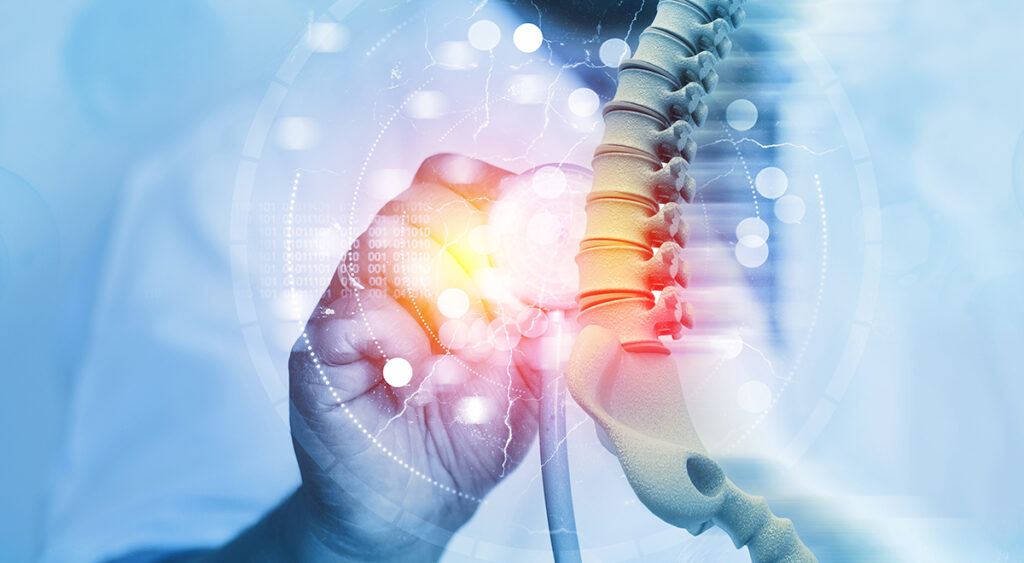
Often, it stems from pressure, irritation, or damage to the sciatic nerve.
Damage or deformation to the spinal disks can compress these nerves, leading to nerve pain and loss of function. Degenerative disk diseases and herniated or slipped disks can often lead to sciatica.
Spinal stenosis and foraminal stenosis are both conditions that constrict the available space around the nerves, potentially leading to the compression of the sciatic nerve.
Structural abnormalities can also contribute to sciatica. Spondylolisthesis, for example, occurs when a vertebra slips out of its normal position and might exert pressure on the nerves. Osteoarthritis, a degenerative joint disease, can lead to the formation of bone spurs that impinge on the sciatic nerve.
Conditions such as conus medullaris syndrome, involving damage or compression of the lower spinal cord, and cauda equina syndrome, characterized by compression of nerve roots at the lower end of the spinal cord, can also result in sciatic nerve impingement.
Additionally, tumors, cysts, and other growths might also cause sciatica.
Risk factors for sciatica
Some conditions and lifestyle factors might increase your risk of developing sciatica. Some common risk factors include:
- Pregnancy
- Injury
- Age-related wear and tear
- Poor posture or weak core muscles
- Type 2 diabetes
- Smoking
- Obesity
Diagnosing sciatica
Since sciatica is merely a symptom, it is crucial to pinpoint and address the root cause. So, your healthcare provider will prioritize identifying the underlying issue while, at the same time, providing relief for the associated symptoms as well.
During diagnosis, doctors will assess your medical history and perform a physical examination, evaluating the range of motion, pain symptoms, muscle strength, and reflexes.
Imaging tests, such as X-rays and MRI or CT scans, can help identify the source of the sciatic nerve dysfunction and rule out other conditions.
Sciatica can be categorized into two different types. True sciatica is when a condition directly affects the sciatic nerve. And sciatica-like conditions are ones that might feel like sciatica, but they don't actually involve irritation, compression, or other impingement of the sciatic nerve itself. While the symptoms are usually the same, distinguishing between the two types is essential for accurate diagnosis and determining the appropriate course of treatment.
Sciatica treatments
The treatment approach for sciatica depends on the severity of symptoms and the underlying cause.
Doctors will try to fix the source of dysfunction whenever possible. Depending on the underlying cause of sciatica, this might mean resting, physical therapy, a course of medications, or in some cases, surgery.

However, it's not always possible to eliminate the cause of sciatica. When you have chronic sciatica, treating the symptoms becomes crucial to restore your quality of life and range of movement. Even in cases where sciatica is only temporary, treating the symptoms can make the recovery process more comfortable.
A vital part of this treatment process is restoring the range of motion and muscle function. Depending on the severity of sciatica, this might be achieved with certain medications, gentle physical activity, like stretches and special exercises, or in some cases, assistive devices.
Sciatica most often causes nerve pain in the lower back, the buttocks, or the legs. Pain management methods, like painkillers, steroid injections, natural remedies, and alternative therapies, can ease these symptoms. If you'd like to learn more about your available pain relief options, make sure to read our article on sciatica pain relief as well!
Managing Sacroiliac Joint Pain: Effective Treatment Options
Sacroiliac joint pain is one of the lesser-known joint conditions. This doesn't make it any less painful or hindering, but it might be harder to recognize when you have it, which is why it's so important to understand the condition.
In this article, we will talk about the sacroiliac joint, its function, potential causes of pain in the area, and your treatment options. Stay with us if you'd like to learn more about sacroiliac joint pain and find the best pain relief options.
Understanding the sacroiliac joint
When it comes to joints, the ones that first come to mind are the knees, shoulders, elbows, and probably the wrists. The sacroiliac joint - often referred to as the SI joint or SIJ - is less apparent than those.
We can find it in the pelvis, connecting the sacrum and the ilia. Its function is vital, as it bears the weight of the entire upper body, transfers torque and acts as a shock absorber for the spine.
Sacroiliac joint dysfunction is often confused with other lower back conditions. The pain might appear in the lower back and the buttocks and radiate to the legs, groin, or hips. So, sometimes it might be hard to pinpoint the source of the pain.
What causes sacroiliac joint pain?
Sacroiliac joint pain can stem from many different conditions. We will take a look at the most common ones.
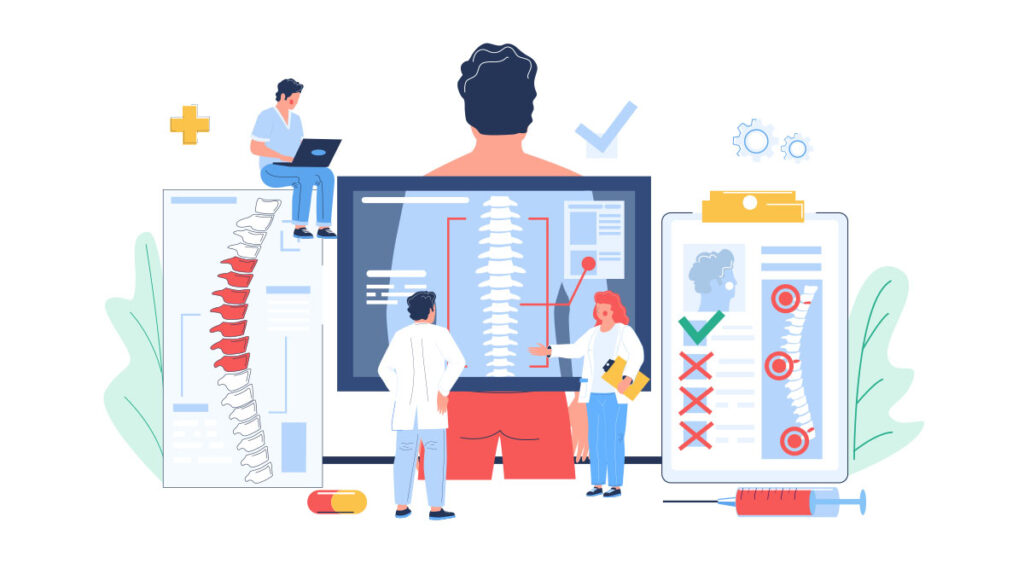
Injury or trauma
The SI joint has a shock-absorbing function, but it has its limits. The force of a fall or an accident could cause damage to the joint, which might lead to acute or chronic pains.
Arthritis
Arthritis is a term that encompasses many different joint conditions. Some of these could affect the sacral joints as well.
Osteoarthritis, a wear-and-tear disease, might sometimes appear in the SI joints. Systemic inflammatory arthritides like rheumatoid arthritis could also cause sacrum pain. Ankylosing spondylitis is a form of arthritis that causes inflammation in the spinal joints, and can affect the sacral area as well.
Pregnancy
During pregnancy and delivery, the sacroiliac joint is subject to extreme stress. Its weight-bearing function becomes even more important, the changes in movement may put more stress on the joints, and the joint has to loosen and stretch to give space during delivery. These may lead to sacral pain.
Infection
In some cases, local or systemic infections might affect the sacroiliac joint. When this occurs, we might experience other symptoms, like fever, besides the joint pain.
Inflammatory conditions
SIJ pain might also result from some inflammatory diseases or autoimmune conditions. Lupus, for example, is one of the autoimmune diseases that attacks the joints as well. These systemic conditions usually come with a plethora of other symptoms.
Diagnosing sacroiliac joint dysfunction
Diagnosing SI joint dysfunction might be challenging, as its symptoms are similar to other lower back conditions.
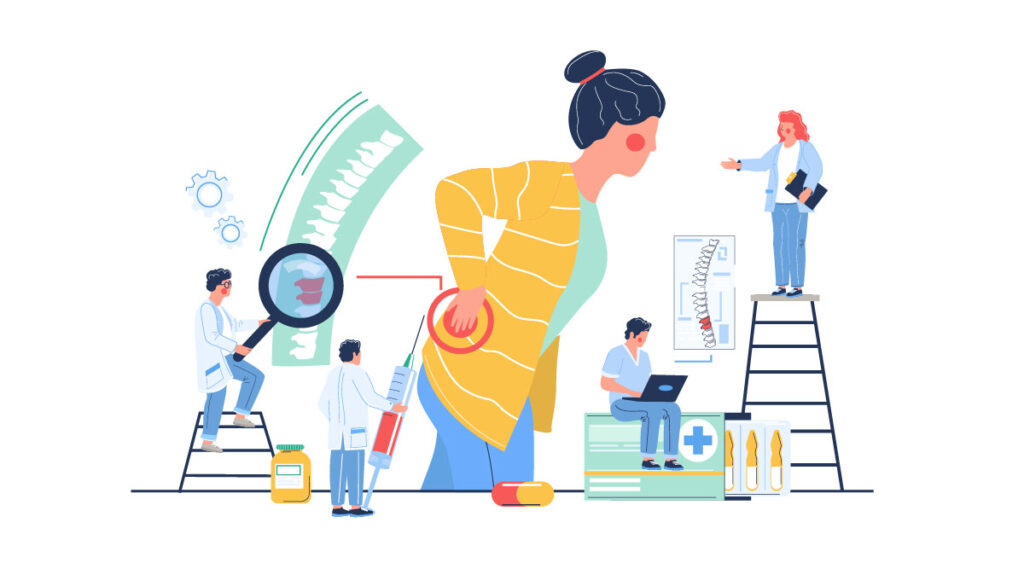
Doctors usually perform multiple tests, like orthopedic provocations and X-ray or MRI imaging, to pinpoint the cause of pain. One surefire way to diagnose sacroiliac joint pain is to inject numbing agent directly into the joint. If the pain goes away, that indicates that the cause lies within the joint.
Treatment options for sacroiliac joint pain
The course of treatment for SI pain depends on the underlying cause. Different conditions might call for different treatment methods.
Medications for SI joint dysfunction
OTC or prescription painkillers can provide reliable pain relief.
Sacroiliac dysfunction might also cause muscle spasms which could be treated with muscle-relaxing drugs.
If you are dealing with an autoimmune condition, doctors might recommend DMARDs or immunosuppressants.
In some cases, doctors might use corticosteroid injections to alleviate pain, inflammation, and joint stiffness. The effect of these injections usually lasts for an extended period of time.
Physical therapy
Certain exercises for SI joint pain can help manage your symptoms. Physical therapists can teach you the right exercises for your condition. Gentle stretches might reduce pain and improve mobility. And strengthening the muscles around the painful area can help stabilize the joint and reduce stress.
When dealing with SI joint pain, it's crucial to keep a proper posture, as this will help distribute weight more evenly and reduce the load on the painful joint. So, improving your posture could be another way to relieve sacroiliac joint pain.
You might also consider changing your routine movements and investing in an ergonomic office chair and a mattress. These can reduce stress on the SI joint during everyday activities.
Alternative remedies for sacroiliac joint dysfunction
Some alternative pain relief methods can effectively supplement your pain management routine.
Allowing the painful joints to rest and avoiding further stress is always advisable when dealing with joint pains.
Heat and cold therapy is a science-backed and effective method that might help ease lesser pains, and it doesn't interfere with traditional drugs.
Some herbal remedies might also reduce pain and inflammation. Capsaicin and menthol for example.
You can also use drug-free pain patches, like our Freedom patch, in addition to or in place of standard painkillers. Our innovative vibrotactile technology brings pain relief without the side effects of drugs.
How to Identify and Treat Neuropathy
The word neuropathy means nerve damage or dysfunction. While it's often referred to as a disease, it is not one condition but rather an umbrella term encompassing a variety of conditions.
Neuropathy might come in different forms and with a broad range of symptoms, so understanding them is crucial to identify and treat the issue.
In this article, you will learn about different forms of neuropathy, their symptoms, causes, and possible treatment options.
What is neuropathy?
The nervous system is a network inside our body that allows us to control bodily functions. It consists of different nerves and cells that transfer messages throughout the system, divided into two main areas. The central nervous system includes the spinal cord and the brain, while all the rest are part of the peripheral nervous system.
When these nerves get damaged, irritated, or disturbed in some other way, we call that neuropathy.
Types of neuropathy
Neuropathy is a broad term referring to all sorts of nerve problems. Depending on symptoms, underlying causes, and the affected area, we can identify four types of neuropathy.
Cranial neuropathy
Cranial neuropathy occurs when the nerves in the brain or brainstem are subject to damage, trauma, or irritation.
There are 12 pairs of cranial nerves in this area, and they help us process sensory information and control movement.
Cranial neuropathy often affects our vision, taste, hearing, or facial muscles. It's possible to suffer damage to more than one of these nerves, in which case doctors might diagnose multiple cranial neuropathies.
Cranial neuropathy symptoms
People may experience different symptoms depending on which nerves are affected. The following are some common symptoms of cranial neuropathies:
- Tingling sensation or numbness
- Increased sensitivity to touch
- Muscle weakness or paralysis
- Obscured vision
- Neuropathic pain
Most of these symptoms occur in the facial area, like a sudden weakness of facial muscles, drooling, or difficulty controlling eye movement.
Peripheral neuropathy
The peripheral nervous system weaves through our entire body, breaching out from the brain and the spinal cord. It connects the central nervous system to other areas, like the limbs, organs, etc.
When any of these nerves suffer damage, it falls under the broad category of peripheral neuropathy.
Peripheral neuropathy is the most common among all types of neuropathies, so people might often refer to it simply as neuropathy.
Peripheral neuropathy symptoms
Considering how enormous and complex this system is, peripheral neuropathy may encompass a wide range of medical conditions. These conditions might come with varying symptoms, sometimes unique to the affected nerves and their functions. Some common symptoms across multiple of these conditions might include:
- Sharp pain
- Increased, unpleasant sensitivity of the skin
- Decreased ability to coordinate movements
- Muscle weakness or paralysis
- Numbness or tingling in the limbs
Peripheral neuropathy might often affect the limbs, causing sensations of pain, sensitivity, or numbness. Another common sign of peripheral neuropathy conditions might be problems with movements and motor functions.
Focal neuropathy
Focal neuropathy conditions affect a single nerve in the body. The issue is often related to muscles or other tissues pressing on or irritating the nerve, causing various uncomfortable sensations.
The underlying causes might vary. The nerves might get irritated by swollen muscles or tissues due to inflammation or overuse, physical pressure resulting from bone spurs or other deformities, nerve damage from diabetes, or a herniated disc.
Common areas affected by focal neuropathy might be the feet, the legs, the torso, and the hands. But it might also occur in any other area of the body.
Focal neuropathy symptoms
A telltale sign of focal neuropathy might be that, most of the time, it only affects a limited area. So the common symptoms listed below usually become apparent only locally.
- Numbness or tingling
- Muscle weakness
- Painful sensation
- Inflammation in the area
One of the most well-known focal neuropathies is carpal tunnel syndrome, where the swollen tendons of the wrist press on the median nerve, causing numbness, tingling, and pain in the wrist and the thumb side of the hand.
Autonomic neuropathy
The autonomic nervous system is a part of our peripheral nervous system, responsible for regulating automatic body functions like breathing, digestion, and heart functions.
Autonomic neuropathy occurs when there's damage or dysfunction in this system. These dysfunctions can lead to various problems like an unregulated heartbeat or blood pressure, digestive problems, and bladder issues.
Autonomic neuropathy symptoms
The symptoms of autonomic neuropathy might be quite different, depending on which bodily functions are affected. Below, we will look at the most commonly affected autonomic systems and list some typical symptoms for each.
Heart regulation
When the nerves controlling your heart functions are damaged, your body might have issues regulating your heartbeat and blood pressure. This might lead to irregular heartbeat, fainting when you stand up, or during physical activity, and it can prevent you from feeling pain during other heart problems like a heart attack.
Bladder regulation
Damage to the nerves regulating your bladder functions can cause leaking and the loss of the ability to hold urine. Additionally, holding urine for too long might lead to bladder infections.
Digestive system
When autonomic neuropathy occurs in the nerves of the digestive system, it can lead to nausea, bloating, diarrhea, constipation, vomiting, or problems swallowing.
Eyes
Autonomic neuropathy might affect our pupils, hindering our reaction time to light changes and making driving a car or navigating in darker places harder.
Sweat glands
Autonomic neuropathy of the nerves controlling the sweat glands might lead to extensive sweating in some areas or dryness in others. This might affect our body's ability to regulate its temperature.
Reproductive organs
Damage to nerves in the genitalia might cause erectile dysfunction or ejaculation problems in men and loss of sensitivity or decreased arousal fluids in women.
Neuropathy treatments
As we can see, neuropathy can refer to a broad range of issues throughout our nervous system, each with unique symptoms and treatment options.
So, before starting any treatment, doctors would have to identify the source of the problem and any underlying issues. Only then can a course of treatment be set.
Treatments for neuropathies can be as simple as rest, or they might require long-term treatment with drugs, and in some cases, surgery might be the only option.






